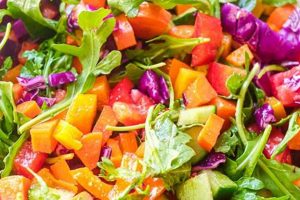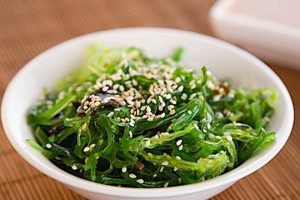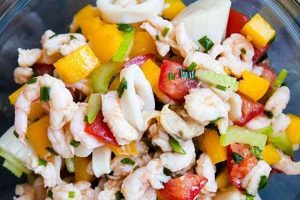A combination of shredded carrots and pineapple, this dish often includes other ingredients like raisins, coconut, and nuts. Variations exist with different dressings, ranging from creamy mayonnaise-based options to lighter vinaigrette styles, creating a sweet and tangy flavor profile. An example might include grated carrots, chunks of fresh pineapple, shredded coconut, and a dressing made with mayonnaise, yogurt, and a touch of lime juice.
This type of salad offers a refreshing and flavorful way to consume fruits and vegetables, contributing essential vitamins, minerals, and dietary fiber. Historically, combining fruits and vegetables in sweet salads has been a popular culinary practice across various cultures. The accessibility of ingredients and the simplicity of preparation make it a versatile dish suitable for potlucks, picnics, or everyday meals. Its adaptability allows for adjustments to sweetness and texture, catering to a wide range of preferences.
This exploration will further delve into the diverse variations of this salad, offering specific recipes and examining the nutritional benefits of key ingredients. It will also provide tips for preparation, storage, and serving suggestions for different occasions.
Tips for Carrot Pineapple Salad
Optimizing ingredient selection and preparation techniques enhances the flavor and texture of this versatile dish. Attention to detail ensures a consistently satisfying culinary experience.
Tip 1: Freshness is Key: Select ripe, fragrant pineapples and firm, brightly colored carrots. Avoid canned pineapple packed in heavy syrup, as it can add excessive sweetness and a less desirable texture.
Tip 2: Grating Consistency: Uniformly grated carrots contribute to a pleasing texture. A box grater or food processor offers consistent results. Avoid chopping carrots into large pieces, as this can create an unbalanced texture.
Tip 3: Balancing Sweetness and Acidity: The dressing should complement the natural sweetness of the pineapple and carrot. A touch of acidity, such as lime or lemon juice, can brighten the flavors and prevent the salad from becoming overly sweet.
Tip 4: Enhancing Texture with Add-ins: Consider incorporating ingredients like raisins, shredded coconut, chopped nuts, or sunflower seeds to add textural complexity and flavor depth.
Tip 5: Dressing Application: Add the dressing just before serving to prevent the salad from becoming soggy. Toss gently to ensure even distribution of the dressing.
Tip 6: Chill Time Optimization: Chilling the salad for a short period allows the flavors to meld. However, avoid excessive chilling, which can diminish the vibrancy of the fresh ingredients.
Tip 7: Creative Serving Suggestions: This salad complements various dishes. Consider serving it alongside grilled meats, fish, or poultry. It also functions well as a standalone light lunch or side dish.
By adhering to these guidelines, one can consistently produce a vibrant and flavorful salad that offers both nutritional value and culinary satisfaction. Careful attention to ingredient quality and preparation techniques elevates this simple dish to a delightful culinary experience.
These tips offer a pathway to crafting a truly exceptional salad experience. The following section will offer concluding remarks and reiterate the versatility and appeal of this dish.
1. Ingredients
Ingredient selection significantly influences the final flavor profile, texture, and nutritional value of a carrot pineapple salad. Careful consideration of each component ensures a balanced and enjoyable culinary experience. The following facets explore key ingredient categories and their impact on the overall dish.
- Base Ingredients: Carrots and Pineapple
These form the foundation of the salad. Freshness is crucial. Ripe, sweet pineapples and firm, crisp carrots provide the optimal flavor and texture. Pre-cut pineapple can be used for convenience, but fresh pineapple offers superior flavor. The proportion of carrot to pineapple influences the overall sweetness and texture of the salad. A higher ratio of carrots yields a less sweet, more substantial salad.
- Sweeteners:
While the pineapple provides inherent sweetness, additional sweeteners can be incorporated to adjust the flavor profile. Options include raisins, dried cranberries, or a touch of honey or maple syrup in the dressing. However, moderation is essential to avoid excessive sweetness. The natural sugars in the fruit often suffice.
- Textural Elements:
Adding ingredients like shredded coconut, chopped nuts (walnuts, pecans, or macadamia nuts), or sunflower seeds introduces textural complexity and enhances the overall sensory experience. These additions also contribute healthy fats and protein to the salad.
- Dressing:
The dressing binds the ingredients together and adds another layer of flavor. Creamy dressings, typically mayonnaise-based, provide richness and tang, while lighter vinaigrettes offer a brighter, more acidic counterpoint to the sweetness of the fruit. The choice of dressing significantly impacts the overall flavor profile and caloric content.
The interplay of these ingredient categories contributes to the overall success of the salad. A well-balanced combination of fresh produce, complementary sweeteners, textural elements, and a suitable dressing creates a harmonious and satisfying dish. The quality and freshness of the ingredients directly impact the final result, underscoring the importance of thoughtful ingredient selection.
2. Preparation
Preparation significantly impacts the overall quality and enjoyment of carrot pineapple salad. Proper techniques enhance both the texture and flavor profile. Consider the following steps crucial to achieving optimal results:
- Carrot Preparation: Washing, peeling, and grating carrots uniformly ensures a consistent texture and maximizes surface area for optimal flavor absorption from the dressing. Unevenly sized pieces can lead to a less appealing texture and inconsistent flavor distribution.
- Pineapple Preparation: Fresh pineapple requires peeling, coring, and cutting into bite-sized pieces or grating. Canned pineapple offers convenience but may require draining to adjust sweetness and texture. If using fresh pineapple, efficient removal of the core is essential to eliminate tough, fibrous portions.
- Ingredient Combination: Gentle mixing prevents crushing delicate ingredients and maintains a desirable texture. Overmixing can lead to a mushy consistency, especially if using canned pineapple. Combining ingredients just prior to serving helps preserve freshness and prevents the salad from becoming watery.
- Dressing Incorporation: Adding the dressing just before serving prevents the salad from becoming soggy and maintains the crispness of the ingredients. Even distribution of the dressing ensures a balanced flavor profile.
Precise execution of these steps contributes to a successful outcome. For example, neglecting to remove the core of a fresh pineapple can result in tough, woody pieces in the salad, diminishing the overall enjoyment. Similarly, grating carrots too coarsely can lead to a less desirable texture. Thorough washing of all produce removes potential contaminants and ensures food safety. Proper preparation maximizes the appeal and enjoyment of this simple yet refreshing dish.
Careful preparation directly influences the overall culinary experience. Attention to detail, including even grating, appropriate pineapple preparation, and timely dressing incorporation, ensures a visually appealing and flavorful salad. Consistent implementation of these techniques elevates this seemingly simple dish to a consistently satisfying culinary creation.
3. Dressing
Dressing is a critical component of carrot pineapple salad, significantly influencing the overall flavor profile and textural experience. The choice of dressing transforms the character of the salad, creating variations ranging from rich and creamy to light and tangy. A well-chosen dressing complements the inherent sweetness of the pineapple and carrot, enhancing their natural flavors without overpowering them. Exploring the various dressing options provides insights into their individual characteristics and impact on the final dish.
- Creamy Dressings
Mayonnaise-based dressings offer a rich, smooth texture that coats the ingredients, creating a decadent mouthfeel. Variations often incorporate sour cream or yogurt for added tang and creaminess. A classic example is a dressing made with mayonnaise, Greek yogurt, and a touch of lime juice. This style of dressing complements the sweetness of the fruit, adding a savory counterpoint. The creamy texture also binds the ingredients together effectively.
- Vinaigrettes
Vinaigrettes provide a lighter, brighter alternative to creamy dressings. Typically made with oil and vinegar, they offer a tangy, refreshing contrast to the sweetness of the pineapple and carrot. A simple vinaigrette might consist of olive oil, apple cider vinegar, and a touch of honey or maple syrup. Vinaigrettes allow the natural flavors of the ingredients to shine through while adding a refreshing acidity.
- Yogurt-Based Dressings
Yogurt-based dressings offer a balance between creamy and light. Greek yogurt provides a tangy base that can be customized with various flavors. For example, a dressing made with Greek yogurt, honey, and a hint of ginger offers a unique flavor profile that complements the sweetness of the fruit while adding a subtle spice note. Yogurt-based dressings contribute a creamy texture while remaining lighter than traditional mayonnaise-based options.
- Citrus-Based Dressings
Citrus-based dressings highlight the bright, tangy flavors of citrus fruits. A dressing made with fresh orange juice, lime juice, and a touch of olive oil creates a vibrant, refreshing flavor profile. The citrus notes enhance the sweetness of the pineapple and carrot, creating a balanced and harmonious taste. These dressings offer a lighter alternative while adding a burst of fresh flavor.
The selection of dressing elevates carrot pineapple salad beyond a simple combination of ingredients. Each dressing type offers a unique flavor profile and texture, enhancing the overall sensory experience. From the richness of creamy dressings to the brightness of vinaigrettes, the choice of dressing significantly impacts the final result. Understanding the characteristics of each dressing type allows for informed decisions that cater to individual preferences and desired flavor outcomes. A thoughtfully chosen dressing elevates the salad, transforming it into a well-balanced and satisfying dish.
4. Variations
The inherent adaptability of carrot pineapple salad allows for a wide array of variations, transforming this simple dish into a versatile culinary canvas. Exploring these variations highlights the potential for customization, catering to diverse palates and dietary preferences. Understanding the various components and their impact on the final product empowers culinary creativity and expands the possibilities of this classic salad.
- Fruit Incorporation
Expanding beyond the core ingredients of carrots and pineapple opens avenues for incorporating other fruits. Adding chopped apples, grapes, or mandarin oranges introduces new flavor dimensions and textural complexities. For instance, the tartness of green apples contrasts with the sweetness of pineapple, while the juiciness of grapes adds a burst of freshness. These additions create a more complex flavor profile and enhance the nutritional value of the salad.
- Vegetable Additions
Incorporating additional vegetables enhances the nutritional content and textural diversity of the salad. Shredded red cabbage adds a vibrant color and a slightly peppery flavor, while chopped celery contributes a crisp, refreshing element. These additions create a more substantial salad, offering a wider range of nutrients and a more satisfying textural experience.
- Nut and Seed Integration
Integrating nuts and seeds elevates the salad’s nutritional value and introduces textural contrasts. Toasted sunflower seeds, slivered almonds, or chopped walnuts provide healthy fats, protein, and a satisfying crunch. The choice of nuts or seeds influences the overall flavor profile, adding nutty or earthy notes that complement the sweetness of the fruit. These additions contribute to a more balanced and satisfying meal.
- Dressing Diversification
The choice of dressing significantly impacts the flavor profile of the salad. Creamy dressings like mayonnaise-based options offer a rich, tangy counterpoint to the sweetness of the fruit, while lighter vinaigrettes provide a refreshing acidity that enhances the natural flavors of the ingredients. Experimenting with different dressings, such as a citrus vinaigrette or a ginger-yogurt dressing, allows for customization and caters to individual preferences.
These variations demonstrate the versatility of carrot pineapple salad, transforming it from a basic dish into a customizable culinary creation. By understanding the impact of different ingredients and preparation techniques, one can create a salad that perfectly aligns with individual tastes and dietary needs. The potential for variation is vast, limited only by culinary imagination. From simple additions to more complex combinations, the possibilities for creating a unique and satisfying carrot pineapple salad are endless.
5. Serving
Serving considerations significantly impact the overall dining experience of a carrot pineapple salad. Appropriate presentation enhances visual appeal and complements the flavors of the dish. Practical aspects, such as temperature and accompanying dishes, further influence enjoyment. Understanding these elements allows for a more complete and satisfying culinary experience.
Temperature plays a crucial role in optimizing the salad’s flavor profile. Serving the salad chilled enhances the refreshing qualities of the pineapple and other ingredients. However, excessive chilling can dull the flavors and create an unpleasant texture. Room temperature serving is acceptable for shorter durations, particularly if incorporating warmer elements like toasted nuts or grilled chicken. Accompanying dishes also influence the overall experience. This salad complements grilled meats, fish, or poultry, offering a refreshing contrast to richer flavors. It also functions well as a standalone light lunch or as part of a buffet spread. Presentation further enhances enjoyment. Serving the salad in a decorative bowl or arranging it on individual plates with garnishes like fresh mint or toasted coconut adds visual appeal. The choice of serving vessel and accompanying garnishes should complement the overall aesthetic of the meal.
Practical considerations, such as portion size and timing, are also essential. Serving appropriate portions prevents food waste and ensures guests receive adequate amounts. Timing is crucial for maintaining optimal freshness and preventing the salad from becoming soggy, especially if using a creamy dressing. Serving the salad immediately after preparation or keeping it chilled until serving ensures the best possible texture and flavor. Understanding the interplay of these factors contributes to a more satisfying dining experience, highlighting the importance of serving as an integral component of enjoying carrot pineapple salad.
6. Storage
Proper storage maintains the quality, flavor, and safety of carrot pineapple salad, preventing spoilage and maximizing its shelf life. Understanding appropriate storage techniques is crucial for preserving the freshness and crispness of the ingredients, especially given the perishable nature of fruits and vegetables. Neglecting proper storage can lead to bacterial growth, undesirable textural changes, and diminished flavor. Implementing correct storage practices ensures the salad remains enjoyable and safe for consumption.
- Container Selection
An airtight container is essential for preventing oxidation and maintaining optimal moisture levels. Using a container with a tight-fitting lid minimizes exposure to air, which can cause the ingredients to dry out and lose their vibrant colors. Selecting an appropriately sized container prevents excess air space, further reducing the risk of spoilage. Glass or high-quality plastic containers are suitable options.
- Refrigeration
Refrigeration is crucial for preserving the freshness of carrot pineapple salad. Storing the salad at a temperature below 40F (4C) inhibits bacterial growth and slows down enzymatic processes that lead to spoilage. Placing the container at the back of the refrigerator, where the temperature is most consistent, further safeguards against temperature fluctuations and bacterial proliferation.
- Separation of Dressing
If using a dressing, storing it separately from the salad ingredients prevents the salad from becoming soggy. Adding the dressing just before serving maintains the crispness of the vegetables and prevents the fruit from releasing excess moisture. This practice ensures a more desirable texture and prevents the dilution of flavors.
- Shelf Life
Even with proper storage, carrot pineapple salad has a limited shelf life. Generally, it is best consumed within 2-3 days of preparation. Beyond this timeframe, the quality of the ingredients begins to deteriorate, and the risk of bacterial contamination increases. Adhering to this timeframe ensures optimal flavor and minimizes food safety risks.
Adherence to these storage practices is paramount for preserving the quality and safety of carrot pineapple salad. Proper container selection, refrigeration, separation of dressing, and awareness of shelf life contribute significantly to maintaining the desired texture, flavor, and safety of this dish. Implementing these guidelines ensures a more enjoyable and safe culinary experience.
7. Nutrition
Nutritional value represents a significant aspect of carrot pineapple salad, offering a combination of vitamins, minerals, and dietary fiber beneficial for overall health. Understanding the nutritional contributions of the core ingredients and the impact of variations provides a comprehensive perspective on the health benefits associated with this dish. Analyzing the nutritional composition allows for informed dietary choices and highlights the potential of this salad as a nutritious meal component.
- Vitamins
Carrots are an excellent source of beta-carotene, which the body converts to vitamin A, essential for vision, immune function, and cell growth. Pineapple contributes vitamin C, a potent antioxidant that supports immune health and collagen production. The combination of these vitamins provides a synergistic benefit, supporting various bodily functions. For example, vitamin A supports healthy skin, while vitamin C aids in iron absorption, further enhancing the nutritional value of the salad.
- Minerals
This salad offers essential minerals like potassium and manganese. Potassium, abundant in carrots, plays a vital role in regulating blood pressure and muscle function. Manganese, present in pineapple, contributes to bone health, wound healing, and metabolism. These minerals, while present in relatively small amounts, contribute to overall health and well-being. Maintaining adequate mineral intake is crucial for various physiological processes, and this salad can contribute to meeting daily requirements.
- Dietary Fiber
Both carrots and pineapple are good sources of dietary fiber, which promotes digestive health and regularity. Fiber adds bulk to the stool, aiding in its passage through the digestive tract and preventing constipation. Adequate fiber intake also contributes to feelings of fullness, which can aid in weight management. This aspect is particularly beneficial for individuals seeking to increase their fiber intake through dietary choices.
- Impact of Variations
Variations in the recipe can influence the overall nutritional profile. Adding nuts or seeds increases the healthy fat and protein content, while incorporating other fruits or vegetables further diversifies the vitamin and mineral content. For example, adding walnuts provides omega-3 fatty acids, beneficial for heart health, while incorporating spinach increases the intake of folate and iron. Understanding the nutritional impact of these variations allows for customization to meet specific dietary needs and preferences.
Consuming carrot pineapple salad offers a flavorful and convenient way to incorporate essential nutrients into one’s diet. The combination of vitamins, minerals, and dietary fiber contributes to overall health and well-being, making this salad a valuable addition to a balanced eating plan. Understanding the nutritional composition empowers informed choices and highlights the potential health benefits associated with regular consumption. From supporting vision and immune function to promoting digestive health, the nutritional value of this salad underscores its importance as a healthful dietary choice.
Frequently Asked Questions
This section addresses common inquiries regarding carrot pineapple salad, providing clear and concise information to facilitate informed preparation and enjoyment.
Question 1: What is the best way to prevent carrot pineapple salad from becoming watery?
Adding the dressing immediately before serving is crucial. Storing the salad and dressing separately until serving time minimizes moisture release from the ingredients.
Question 2: Can canned pineapple be used instead of fresh pineapple?
Canned pineapple can be used, but fresh pineapple generally offers superior flavor and texture. If using canned pineapple, choose one packed in juice rather than heavy syrup to control sweetness, and drain it well before adding to the salad.
Question 3: How long can carrot pineapple salad be stored in the refrigerator?
Properly stored in an airtight container, carrot pineapple salad typically lasts for 2-3 days in the refrigerator. Beyond this period, quality and safety may be compromised.
Question 4: What are some healthy dressing alternatives for carrot pineapple salad?
Greek yogurt-based dressings or light vinaigrettes offer healthier alternatives to traditional mayonnaise-based dressings, reducing overall fat and calorie content while adding tangy flavors. A simple vinaigrette made with olive oil, lemon juice, and a touch of honey offers a light and refreshing option.
Question 5: How can the sweetness of the salad be adjusted?
The sweetness can be adjusted by varying the ratio of carrots to pineapple. More carrots result in a less sweet salad. Adding a small amount of honey or maple syrup to the dressing can also increase sweetness, but moderation is key.
Question 6: Can this salad be prepared in advance for a potluck or gathering?
The salad components can be prepared in advance and stored separately. Combine and dress the salad immediately before serving to maintain optimal texture and prevent sogginess. Transporting the dressing separately is recommended.
Addressing these frequently asked questions provides a comprehensive understanding of key aspects related to preparing and enjoying carrot pineapple salad. This knowledge equips individuals with the necessary information to create a delicious and satisfying culinary experience.
The next section will offer a concluding summary of the insights presented throughout this exploration of carrot pineapple salad.
Conclusion
Exploration of recipes for carrot pineapple salad reveals a dish offering versatility and nutritional value. From ingredient selection and preparation techniques to dressing choices and variations, the potential for customization caters to a broad range of palates and dietary needs. Proper storage ensures optimal quality and safety, while understanding the nutritional composition highlights the health benefits associated with this dish. Addressing frequently asked questions provides practical guidance for successful preparation and enjoyable consumption.
Carrot pineapple salad represents more than a simple combination of ingredients; it embodies a culinary canvas for creative expression. Its adaptability, nutritional value, and ease of preparation position it as a valuable component of a balanced and enjoyable diet. Further exploration of flavor profiles and ingredient combinations promises continued culinary discovery within this seemingly simple yet versatile dish.






